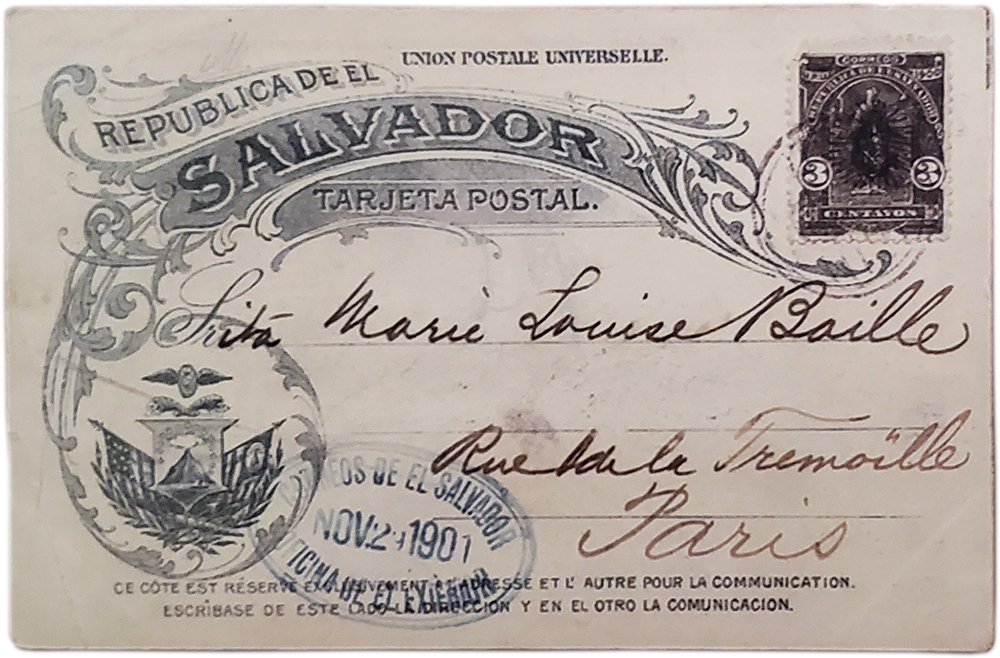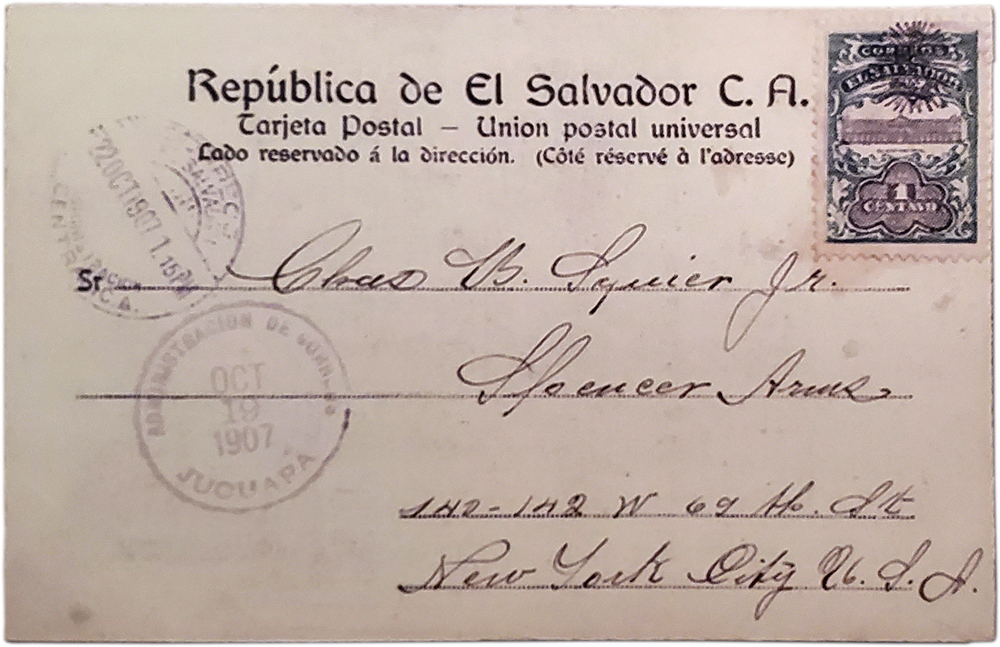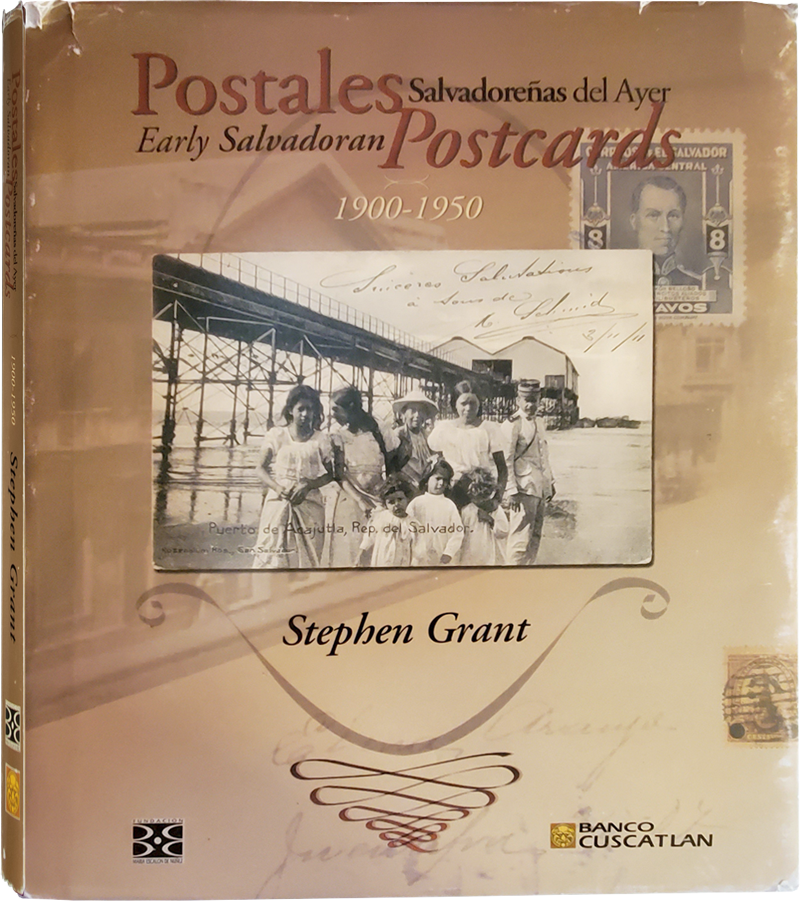Features of Old Postcards
Size & color
Postcards very rarely carry a date printed on the cards. In this, they are unlike most postage stamps, and are much harder to place in time. Exceptions to this are postcards which mark a natural disaster, such as the great San Francisco Fire of 1905 or the 1910 flood in the city of Paris. Commemorative events, such as a visit by a President, King, or Queen, or by a “Minister of the Colonies” to French Africa, for example, often produce explicitly dated cards.
Outside of the rare cases outlined above, the best way of dating a picture postcard is to examine the postmark. This assumes that the postcard was actually sent through the mail. As this book will amply demonstrate, however, most of the old postcards which have survived were never sent. They were bought, collected, and placed in family albums to record travel experiences.
Obviously, the date when a photograph was taken precedes the date when the photograph was made into a postcard and circulated. This lapse of time varies widely. I have a postcard from the Dutch East Indies which was sent in the 1920s and which includes a photograph known to have been taken around 1880. And two examples of the same card from El Salvador, one sent in 1902 and one in 1922.
It also depends on how many postcards, or series of postcards, were produced for sale in a country. Generally, however, one might assume that a postcard photograph might have been taken 1-10 years before its postmarked date.
In this book, when I assign a date to a postcard, I am referring to the date the postcard was sent, or when clues lead me to believe that it was in circulation. Where I suggest a date (a year preceded by a “c” from the Latin circum), it is in comparison with other postcards of the same series that I possess or know about and the dates when they were sent. Not that the date of the photograph is not important; but this is a book more about postcards than about photographs.
Some postmarked dates have been removed by stamp collectors, who value the stamp more than the card, and soak off the stamp. Other postmarks are illegible due to the poor printing equipment or hasty application of the rubber stamp. Consequently, one must resort to a large number of tricks to help date cards. One trick is to know how to read photo paper marks. Photo paper marks are the design and writing that is printed on the address side of the postcard, and where the postage stamp is to be applied. Of course, if the stamp has been affixed there, one cannot see this design!
Stephen Neis of the “Postcard Ring” website has made available on the Internet a very helpful list of photo paper designs, and from his experience, and that of others, has established a range of dates.
With few clear indications, one is obliged to guess the date of the cards: by scrutinizing the style of cloth worn; recognizing a building which was still standing; or know the year a vehicle was produced. To use automobiles to help date a period when a photograph was taken, one needs either to have a vast knowledge of the manufacturers, models, and years, or have access to that expertise. There are many car encyclopedias published covering all makes, models, and countries. Correspondents are often prone to writing the date when they write their message, and this is very helpful.

Postcard from El Salvador’s External Affairs Office to Paris, 1901
Publication
Some postcards clearly show that a foreign country or company was involved in their production. For instance, the cards marked “Libreria Dominiguez, San Salvador, El Salvador, C.A.” contain in the lower right corner, “Stab. Dalle Nogare E Armetti, Milano.” An Italian company, therefore, played some role, most likely that of printer of postcards to be distributed and sold in El Salvador.
The distributor of the largest number (125 cards) of postcards of El Salvador was Victor Hellebuyck from 1946 until 1955. On the front of these cards is written, “Curteich-Chicago ‘C.T. American Art’ Post Card (Reg. U.S. Pat. Off.),” and on the upper right side corner, where the stamp belongs, is written, “Made in U.S.A” These cards were printed in the United States, and sold in El Salvador. One of the oldest cards in the collection was printed in Dresden, Germany, by the Company, Leutret & Schneidewind. These three examples demonstrate the common practice in El Salvador of using foreign partners in printing and perhaps other aspects of postcard manufacturing, such as design.
Postage stamps, postal history
Since so many people who collect and appreciate postcards have an interest in stamps, I have included the Scott Catalog numbers of the stamps which appear on the postcards reproduced in this book. (The Scott Catalog numbers were created in the United States to give a different number to each postage stamp issued in the world. They catalog stamps, not postcards.)
You will notice that many of the cards have the postage stamp affixed on the picture side. This may strike you as strange. Since, in my collection, most of the postcards which display a stamp on the picture side are old cards, I initially assumed that the reason correspondents put the stamp on that side was that they were following to the letter the warning written on many postcards, “Put the address on this side of the postcard.” That is, they were literally putting only the address, and the other side was dedicated to the picture, the message, and the stamp.
Michael G. Price, a more experienced postcard collector than I, however, has stated that this was a common action of postcard collectors, to put the stamp on an inconspicuous corner of the picture side, thus producing a more attractive postcard for someone’s collection. I have, in my collection, one card with a stamp placed folded half on one side, half on the other, by an original or an undecided correspondent!
There is a close affinity between stamp collecting and postcard collecting. Since postage stamps are often placed on postcards, you can often find postcards for sale at stamp dealers. When I have told people in many countries that I collect postcards, many say, “do you mean stamps?” These people have not yet heard of postcard collecting. The Director of Education for the American Philatelic Society, Ms. Kathleen Wunderly, has put her interest in postcards in this simple, engaging way: “Postcards are a quadruple delight: cancel, stamp, picture, message.” In section III, we will make a short inventory of the different types of messages cards may contain.

Postcard sent to Spencer Arms Hotel in NYC’s Upper West Side in the year of its construction, 1907
Censorship
During the Second World War (particularly in 1943 and 1944), people sending postcards from El Salvador (and other countries) to the United States were likely to have their postcards reviewed by a censor in the U.S. Censors were looking for hidden or coded messages which might contain information relating to national security. Censors were known to remove the stamps in this pursuit, but basically they scrutinized the written message.
Censors had a rubber stamp they put generally on the message part of the card. A rectangular red rubber stamp that read “Passed by examiner no. …,” and a round red or black rubber stamp put by the mark. “U.S. censorship, examined by…” The examiner put his number, in pencil or pen, in the space left for that purpose.
This extract was drawn from the author’s book, Postales Salvadoreñas del Ayer/Early Salvadoran Postcards. San Salvador, El Salvador: Fundación María Escalón de Núñez, 1999, 328 pp. Bilingual edition. ISBN 99923-20-01-1.
Postales Salvadoreñas del Ayer
Early Salvadoran Postcards
Early Salvadoran Postcards is one of the first extensive studies published on the old postcards of a Latin American country. The book was conceptualized, researched, developed, designed, and printed in El Salvador.
The section “Collecting Postcards” is designed to answer the fundamental questions people may have about this hobby or pastime. What is a postcard? Where do you find postcards? How much do postcards cost? What do you do with your postcards? Features of old postcards: size & color, type, era, dating, publication, postage stamps, postal history, and censorship. READ MORE
COMMENTS:
CONNECT


0 Comments